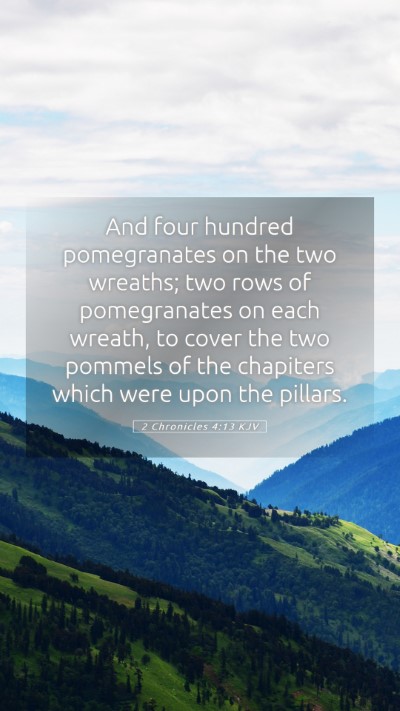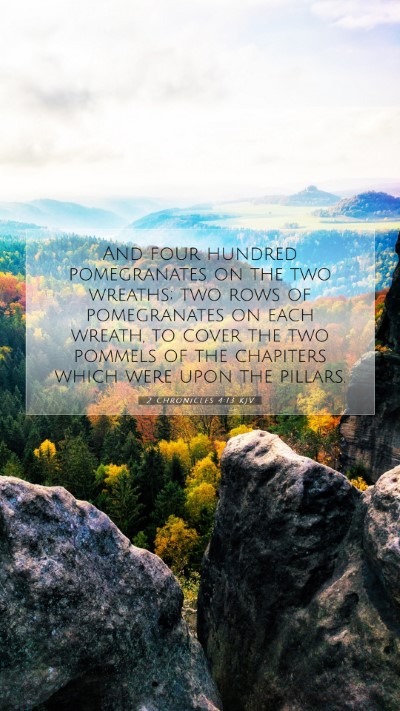Meaning of 2 Chronicles 4:13
This passage is part of the account of Solomon's temple and its furnishings, focusing on the construction and the objects created for worship. In 2 Chronicles 4:13, we read:
"And he made the pillars, and two rows round about upon the one network, to cover the chapiters that were upon the pillars."
Bible Verse Explanations
This verse illustrates the intricate details involved in the construction of Solomon's Temple. The focus on the pillars and the decorative work including networks and chapiters highlights the importance placed on beauty and craftsmanship in the worship of God. Let's explore some key insights:
- Significance of the Pillars: The pillars were symbolic of strength and stability, while also pointing to the majesty of God. Matthew Henry notes that they serve not only a structural purpose but also reflect the dignity of God's house.
- Artistic Décor: Albert Barnes highlights the emphasis on artistry, suggesting that the physical beauty of the Temple is an expression of reverence towards God. The “networks” refer to ornamental decorations, enhancing the appeal of worship.
- Historical Context: Adam Clarke points out that this elaborate design was reflective of the culture and artistry of the time, illustrating how the Israelites were influenced by nearby nations in matters of architecture while still giving glory to God.
- Functionality and Aesthetics: The blending of function (supporting the structure) with aesthetics (pleasing to the eye) showcases a principle seen throughout Scripture: that beauty in worship is important as it reflects God's own majesty.
Understanding Scripture in Depth
When studying this verse, it is crucial to consider:
- Theological Implication: The construction of the temple signifies the establishment of God's presence among His people, and the careful attention to detail underscores the holiness required in divine worship.
- Symbolism of Craftsmanship: The materials and craftsmanship parallel Christ's ultimate sacrifice, as the temple foreshadows Christ's body. This reinforces the idea that God demands our best in worship, echoing themes seen throughout the Bible.
- Legacy of Worship: The descriptions in 2 Chronicles serve as a blueprint for approaching worship in a reverent manner, influencing how subsequent generations understand their relationship with God.
Bible Verse Commentary
The commentaries from Matthew Henry, Albert Barnes, and Adam Clarke provide diverse perspectives on this verse, allowing for a well-rounded understanding:
- Matthew Henry: Discusses the pillars as representations of God’s strength, and emphasizes the necessity of a firm foundation in the life of faith.
- Albert Barnes: Analyzes how decorative elements could indicate the overflow of joy and celebration in worship, inferring that God is worthy of our finest expressions.
- Adam Clarke: Expands on the craftsmanship as a communal project, demonstrating how it required the collaboration of many skilled artisans, reflecting the body of believers working together in faith.
Application of 2 Chronicles 4:13
This verse invites readers to consider how they approach worship and service to God:
- Quality in Service: Just like the temple's construction, believers should strive for excellence in their endeavors for God's kingdom, whether in service, worship, or ministry.
- Symbolic Representations: Consider what pillars represent in your life—strength, support, stability—and seek God's guidance in nurturing these aspects.
- Cultural Influence: While being influenced by culture, maintain a focus on honoring God uniquely. Evaluate how cultural practices align with biblical values in collective worship.
Related Bible Cross References
- 1 Kings 7:15-22: Details the construction of the pillars, elaborating on their significance and design.
- 2 Chronicles 3:15: Introduces the context of the temple's construction and the significance of these elements in worship.
- Exodus 25:40: God commands His people to make all things according to divine patterns, reflecting the importance of obedience in worship.
Conclusion
In examining 2 Chronicles 4:13, it is clear that every detail of the temple's construction serves a greater purpose of glorifying God. By understanding Scripture through these various lenses, believers can gain deeper insights into the nature of worship, craftsmanship, and the relationship between God and His people.


